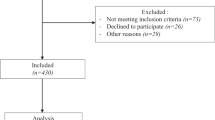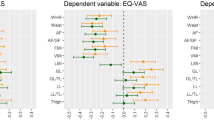Abstract
OBJECTIVES: To evaluate the effects of weight reduction by dieting on musculoskeletal pain, perceived disability and observed functional limitations in everyday life.
SUBJECTS: Female outpatients in weight-loss programmes at the Karolinska Hospital, who met the criteria for participating in this study: age 20–65 y and body mass index (BMI) ⩾30 kg/m2. In all, 57 entered the programme studied and 43 completed it.
INTERVENTIONS: Diet programmes for 8–12 weeks and thereafter 6688 kJ/day for >52 weeks.
MAIN OUTCOME MEASURES: Questionnaires on musculoskeletal symptoms and obesity-specific questions on basic activities of daily living (ADL), mobility, housework, occupational disability and activities outside home. Test protocol developed for observation of functional limitations in obese women. Assessments at baseline, after 12 and after 64 weeks of dieting.
RESULTS: In all, 75% completed the study. Weight loss was 14% (14.7±6.1 kg) at 12 weeks and, due to a weight relapse, 10% (10.1±8.1 kg) at 64 weeks. At the end of the study period, the proportion of current pain from lower backs and feet had normalised. Important perceived improvements were ability to rise from having fallen over, to walk up stairs and to lift heavy things. Most functional limitations improved, such as climbing onto high stools, walking up stairs with grocery bags, doing pedicure, rising from floor or low furniture. The questionnaire results partly followed the weight development, but the observed improvements were long-lasting.
CONCLUSIONS: Weight reduction had positive short-term effects on musculoskeletal pain, perceived disability and observed functional limitations. A partial weight relapse had some impact on perceived pain and disability, but not on observed limitations. The maintained improvements may be due to weight loss, but also less pain and increased physical activity.
This is a preview of subscription content, access via your institution
Access options
Subscribe to this journal
Receive 12 print issues and online access
$259.00 per year
only $21.58 per issue
Buy this article
- Purchase on Springer Link
- Instant access to full article PDF
Prices may be subject to local taxes which are calculated during checkout



Similar content being viewed by others
References
Fine JT, Colditz GA, Coakley EH, Moseley G, Manson JE, Willett WC, Kawachi I . A prospective study of weight change and health-related quality of life in women. JAMA 1999; 282: 2136–2142.
Fontaine KB, Barofsky I, Andersen RE, Bartlett SJ, Wiersima L, Cheskin LJ, Franckowiak SC . Impact of weight loss on health-related quality of life. Qual Life Res 1999; 8: 275–277.
Wadden TA, Steen SN, Wingate BJ, Foster GD . Psychosocial consequences of weight reduction: how much weight loss is enough? Am J Clin Nutr 1996; 63 (Suppl 3): 461–465.
Foster GD, Wadden TA, Kendall PC, Stunkard AJ, Vogt RA . Psychological effects of weight loss and regain: a prospective evaluation. J Consult Clin Psychol 1996; 64: 752–757.
Sullivan M, Karlsson J, Sjöström L, Backman L, Bengtsson C, Bouchard C, Dahlgren S, Jonsson E, Larsson B, Lindstedt S, Náslund I, Olbe L, Wedel H . Swedish obese subjects (SOS)—an intervention study of obesity. Baseline evaluation of health and psychosocial functioning in the first 1743 subjects examined. Int J Obes Relat Metab Disord 1993; 17: 503–512.
Skender ML, Goodrick GK, Del Junco DJ, Reeves RS, Darnell L, Gotto AM, Foreyt JP . Comparison of 2-year weight loss trends in behavioral treatments of obesity: diet, exercise, and combination interventions. J Am Diet Assoc 1996; 96: 342–346.
Walsh MF, Flynn TJ . A 54-month evaluation of a popular very low calorie diet program. J Fam Pract 1995; 41: 231–236.
Evers Larsson U, Mattsson E . Influence of weight loss programmes on walking speed and relative oxygen cost (%VO2max) in obese women during walking. J Rehabil Med 2003; 35: 1–7.
Saris WH . Fit, fat and fat free: the metabolic aspects of weight control. Int J Obes Relat Metab Disord Suppl 1998; 22: 15–21.
Jakicic JM, Clark K, Coleman E, Donnelly JE, Foreyt J, Melanson E, Volek J, Volpe SL, American College of Sports Medicine. Appropriate intervention strategies for weight loss and prevention of weight regain for adults. Med Sci Sports Exerc 2001; 33: 2145–2156.
Blair SN, Kampert JB, Kohl HW, Barlow CE, Macera CA, Paffenberger RS, Gibbons LW . Influences of cardiorespiratory fitness and other precursors on cardiovascular disease and all-cause mortality in men and women. JAMA 1996; 276: 205–210.
Han TS, Tijhuis MA, Lean ME, Seidell JC . Quality of life in relation to overweight and body fat distribution. Am J Public Health 1998; 88: 1814–1820.
Lean ME, Han TS, Seidell JC . Impairment of health and quality of life in people with large waist circumference. Lancet 1998; 351: 853–856.
Evers Larsson U, Mattsson E . Functional limitations linked to high body mass index, age and current pain in obese women. Int J Obes Relat Metab Disord 2001; 25: 893–899.
Han TS, Schouten JS, Lean ME, Seidell JC . The prevalence of low back pain and associations with body fatness, fat distribution and height. Int J Obes Relat Metab Disord 1997; 21: 600–607.
Mattsson E, Evers Larsson U, Rössner S . Is walking for exercise too exhausting for obese women? Int J Obes Relat Metab Disord 1997; 21: 380–386.
Kiernan M, King AC, Kraemer HC, Stefanick ML, Killen JD . Characteristics of successful and unsuccessful dieters: an application of signal detection methodology. Ann Behav Med 1998; 20: 1–6.
Foster GD, Wadden TA, Vogt RA, Brewer G . What is a reasonable weight loss? Patients' expectations and evaluations of obesity treatment outcomes. J Consult Clin Psychol 1997; 65: 79–85.
Örebroformulär 007D. FSF-METOD AB. Örebro: Sweden.
Kuorinka I, Jonsson B, Kilbom Å, Vinterberg H, Biering-Sörensen F, Andersson G, Jörgensen K . Standardised Nordic questionnaires for the analysis of musculoskeletal symptoms. Appl Ergon 1987; 18: 233–237; (www.sciencedirect.com).
Evers Larsson U, Mattsson E . Perceived disability and observed functional limitations in obese women. Int J Obes Relat Metab Disord 2001; 25: 1705–1712.
Borg GAV . Borg's perceived exertion and pain scales. Human Kinetics: Leeds, 1998.
Siegel S, Castellan Jr NJ . The case of K related samples. In: Siegel S, Castellan Jr NJ (eds). Nonparametric statistics for the behavioral sciences. McGraw-Hill Book Co.: Singapore, 1998. pp 180–181.
Bruton A, Conway JH, Holgate ST . Reliability: What is it, and how is it measured? Physiotherapy 2000; 86: 94–99.
Sullivan M, Karlsson J, Ware JE . The Swedish SF-36 Health Survey I. Evaluation of data quality, scaling assumptions, reliability and construct validity across general population in Sweden. Soc Sci Med 1995; 41: 1349–1358.
Sullivan M, Karlsson J, Sjöström L, Taft C . Why quality of life measures should be used in the treatment of patients with obesity. In: Björntorp P (ed). International textbook of obesity. John Wiley & Sons: Chichester, 2001.
Verbrugge LM, Jette AM . The disablement process. Soc Sci Med 1994; 38: 1–14.
Fontaine KR, Bartlett SJ, Barofsky I . Health-related quality of life among obese persons seeking and not currently seeking treatment. Int J Eat Disord 2000; 27: 101–105.
Ljungquist T, Jensen IB, Nygren Å, Harms-Ringdahl K . Physical performance tests for people with long-term spinal pain—aspects of construct validity. J Rehabil Med 2003; 35: 69–75.
Barofsky I, Fontaine KR, Cheskin LJ . Pain in the obese: impact on health-related quality-of-life. Ann Behav Med 1998; 19: 408–410.
Acknowledgements
This study was supported by the Neurotec Department, Division of Physiotherapy, and the Committee for the Health and Caring Sciences at the Karolinska Institutet. The study was carried out at the Division of Physiotherapy and the Department of Medicine at the Karolinska Institutet. We thank Professor Stephan Rössner and his staff for generously providing patients, and we are very grateful to all these patients for spending time to participate in our study. We are much obliged to Elisabeth Berg, statistician, KI, and Tim Crosfield, linguistic reviewer, for their help.
Author information
Authors and Affiliations
Corresponding author
Rights and permissions
About this article
Cite this article
Evers Larsson, U. Influence of weight loss on pain, perceived disability and observed functional limitations in obese women. Int J Obes 28, 269–277 (2004). https://doi.org/10.1038/sj.ijo.0802534
Received:
Revised:
Accepted:
Published:
Issue Date:
DOI: https://doi.org/10.1038/sj.ijo.0802534
Keywords
This article is cited by
-
Pain and emotional eating: further investigation of the Yale Emotional Overeating Questionnaire in weight loss seeking patients
Journal of Behavioral Medicine (2020)
-
Development of the Weight-Related Sign and Symptom Measure
Journal of Patient-Reported Outcomes (2018)
-
Changes in body pain among overweight and obese housewives living in Klang Valley, Malaysia: findings from the MyBFF@home study
BMC Women's Health (2018)
-
Predictors of time to claim closure following a non-catastrophic injury sustained in a motor vehicle crash: a prospective cohort study
BMC Public Health (2016)
-
Prevalence and risk factors for foot and ankle musculoskeletal disorders experienced by nurses
BMC Musculoskeletal Disorders (2014)



